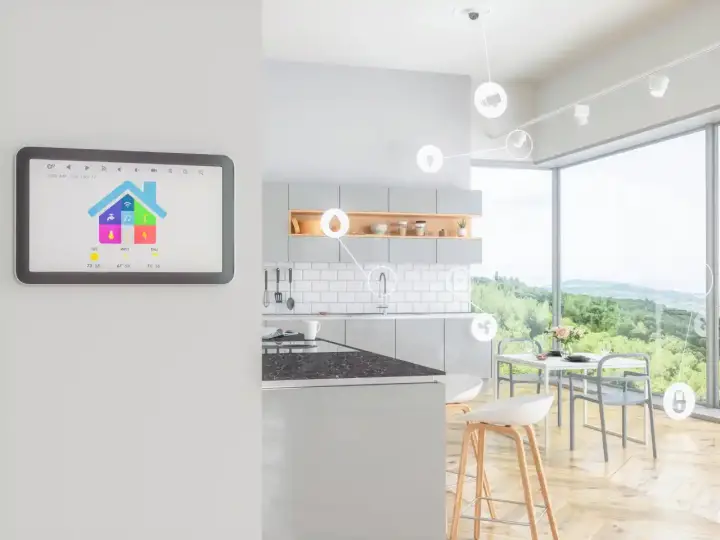5 Important Reasons Why Zigbee Needs To Be Part Of Your Smart Home
Updated on 6th Jun 2021 18:45 in General, IoT, Smart
You may have heard about Zigbee before either from your own experience with it or from a product description that mentions its compatibility with supported smart devices. In many ways, Zigbee is quite similar to the other popular smart home mesh protocol, Z-Wave. They both use devices on the network to form a mesh for point to point communication, they are both wireless protocols that require special hardware, and they are both extremely convenient. Imagine wiring every smart device in your home to a central controller. It would be a total nightmare - which is why wireless communication shines. Despite the similarities to WiFi, these wireless protocols differ in several key areas, most notably the radio frequency they use.

Table of Contents
What is Zigbee, and why does it need to be in your smart home?
Zigbee's main advantage lies in its ability to use nearby nodes to transmit information to the eventual destination. This aspect allows a network to grow very large without worrying about the limited range of other wireless solutions, such as WiFi. A WiFi network has a rather limited range that is mostly dictated by the transmit power of the client device. In other words, the further you get from the WiFi access point, the more powerful the device needs to be to maintain a connection. This is why your phone might have a problem connecting to the WiFi outside, but your laptop can do it just fine. The laptop has a bigger antenna and is more powerful.
Zigbee tackles this problem at its core by making each device on the network responsible for echoing the message to its nearest neighbours. A device on the edge of the network simply needs to communicate with the closest node for a message to reach the smart hub, while a WiFi device has to talk directly with an access point that might be far away. This aspect has a serious effect on the power efficiency of the smart device, something that becomes very important when using batteries. Another advantage is that Zigbee is an open standard, which means developing a product and bringing it to market is rather simple. This usually results in lower prices for consumers.
Are Zigbee and Z-Wave compatible?
Z-Wave is the other protocol commonly used in smart homes, and it shares many similarities with Zigbee. The biggest difference is perhaps that they operate on different radio frequencies and that one is an open standard while the other has more restrictions. Up until 2020, Z-Wave was a completely proprietary ecosystem where a single company reviewed and approved all sold devices under the brand. On the other hand, Zigbee is known for its openness, which allows virtually anyone to build a product that uses the protocol. This does lead to some problems, most notably compatibility problems.
Two Zigbee devices from different manufacturers are not guaranteed to be compatible despite using the same protocol. That's because each company is free to implement the actual smart functionality as they see fit, while Z-Wave requires that each device follow a strict standard. Sending a command for a light to turn on is a standard action such that all Z-Wave bulbs will respond in the same way. This means you can grab virtually any Z-Wave device and expect it to work, while it's going to much more complicated to do that with Zigbee. We can see that Z-Wave and Zigbee will have a hard time being compatible with each other thanks to the different radio frequency each uses, along with the big difference from one standard to another.

Are all Zigbee devices repeaters? Which are?
One of the biggest strengths of a mesh network is its ability to use each node on the network as a repeater to extend its total effective range. Despite this ability, it doesn't always make sense for every device to act as a repeater. For example, consider battery-powered smart devices - no one wants to be constantly replacing batteries, so they need to use as little power as possible. As such, acting as a repeater, even if doing so only uses a bit of power, is not a good idea for these devices. This is why all plugged-in devices act as repeaters while everything else doesn't.
Note that "plugged-in" has a fairly wide definition here, as it refers to anything that gets its power from the grid. This includes bulbs, smart switches, and anything else that stays powered. Generally, the best way to extend the range of your network is to use a device that can fit anywhere, such as a smart bulb or a smart plug. As an example, you could extend the network out into the backyard using a smart bulb in the shed or by having a smart plug plugged in on the wall that faces the yard. As a rule of thumb, check if the device uses batteries - if it does, then chances are you can not use it as a repeater.
Does Zigbee interfere with WiFi?
Zigbee operates at the well known 2.4GHz frequency, which is also the same as most WiFi networks. In fact, 2.4GHz is a special frequency because you do not need a license from the government to use it. Things like the wireless band your cellphone uses require an expensive license to be legally allowed to use it. You could be given fines or worse if you are found to not be respecting these rules. As such, it's important for manufacturers to only use frequencies that are open and legal for anyone to use. This is why WiFi, microwaves, cordless phones, Bluetooth, car alarms, and so much more use this specific frequency. The short answer is that Zigbee could interfere with any of these things, but that the more of them you have, the "noisier" the airwaves become.
If you have a ton of stuff all trying to talk simultaneously on the same frequency, you are probably going to start having some amount of interference. This can result in slowdowns or even connections dropping from your WiFi network, though it could also work the other way around as well. It's worth noting that more modern WiFi access points offer a so-called "5G" network that operates on the 5GHz frequency range. As the frequency is different, there are fewer chances that you will run into problems with interference, and at the very least, it's unlikely that your Zigbee network will be to blame if you do get issues.

Can Zigbee go through walls?
In a home, there are obviously many walls that separate rooms from each other. Depending on where you live, these walls can be made out of anything from wood to concrete. To determine whether a Zigbee signal will be able to get through the walls of your home, you can actually use your existing WiFi network. As both WiFi and Zigbee operate on the same frequency, they will also both have a similar ability to penetrate walls. You may also know that the material your wall is made of can seriously impact the signal's chance of getting through. So what do you do if you currently have a WiFi network and it can barely reach some areas of your home? The first thing to remember is that as a mesh, Zigbee has the extra ability to have the signal repeated right next to the wall in question while WiFi has to transmit from a central location.
As such, if you know you have problems with a specific wall, you can use any of the tips in my article on extending Zigbee's range to increase the chances that it will get through. In the case where you know that your walls are thick and WIFi can't get through at all, you should consider a different solution. For smart homes, an alternative is to use Z-Wave because it operates at a much lower frequency, usually under 1GHz. The lower frequency allows it to get through more materials while also travelling significantly further. The disadvantage is that lower frequencies have lower data transfer speeds, but that shouldn't be that big of a problem for smart home devices.



